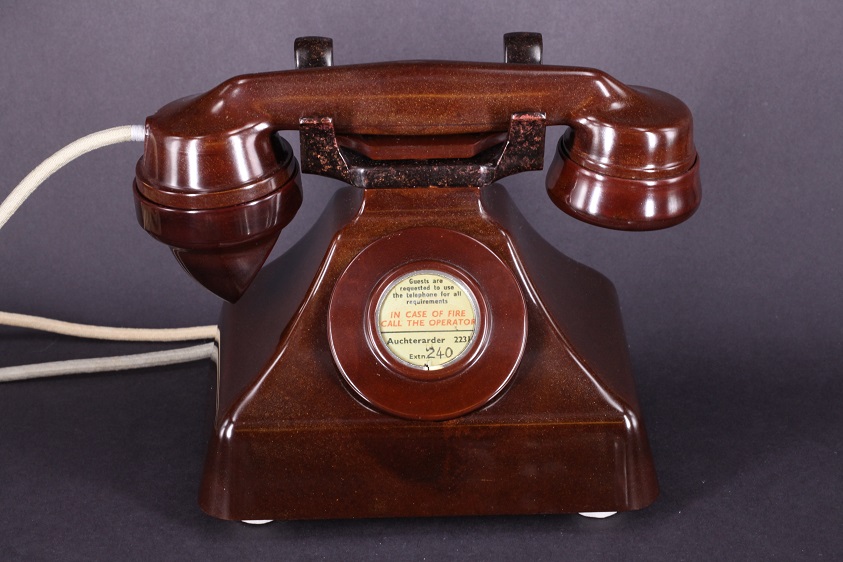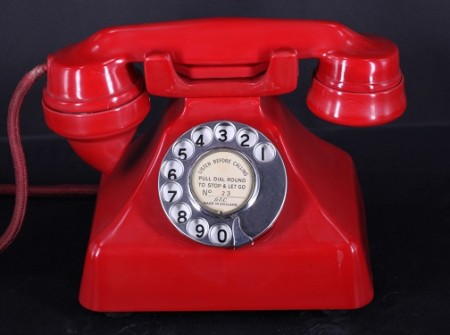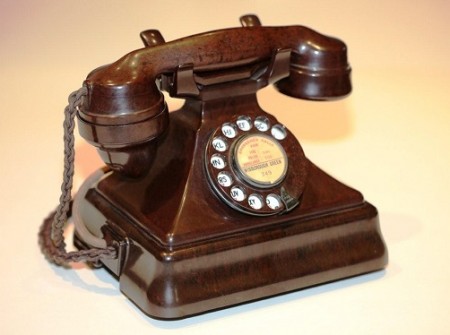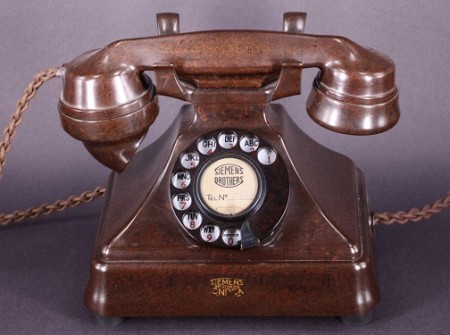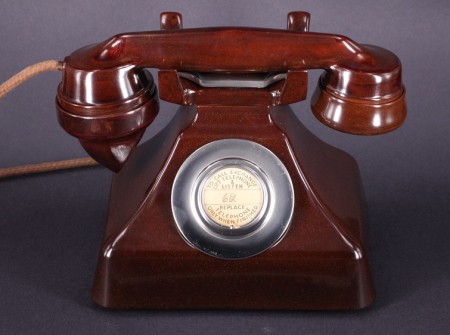1933 Gleneagles Gecophone acquired by its owner at the April 2016 Lyon and Turnbull auction in Edinburgh. Lacquer paint has been removed.
Thanks to renowned collector/dealer Rod Jones for correcting some of the myths in britphones.com’s original draft! And for providing detailed information on his discovery of these phones. Rod tells me that he “is delighted to have provided this extra information to britphones.com for the purpose of intriguing and enlightening collectors worldwide!”
Rod’s lucky find
Rod settled in Edinburgh in Dec 1974 to work as Commercials Producer at Radio Forth, the city’s first commercial radio station.
In 1985, as a sideline to his career in broadcasting, Rod began collecting and converting Bakelite telephones. In next to no time, Rod came across an opportunity to buy some 20 Gecophones plus a green GEC tropical 300 series, which had been languishing in a storeroom at the Gleneagles Hotel. Following many months of haggling, in November 1986, Rod eventually struck a price with the Hotel and the deal was done.
The Gecos were creatively “silvery-pewter-bronze-gold” sprayed, with subtle shadows to the sides and front. But, ironically Rod’s prize was the green GEC 300 series.
After the long drive home from Auchterarder to Edinburgh, Rod started to open up the Gecophones. Beneath the lacquered spray, Rod found that most were black…BUT to his surprise, delight and good fortune he found that a small number of the phones were in a medley of shades of flame mahogany, burgundy and claret-wine colour.
About the Gleneagles Gecophones
The Gleneagles Gecos were ordered by the Hotel’s owner London, Midland and Scottish Railway (LMS) in 1933 and were intended to be part of its Art Deco ambience. There were probably over 100 Gecos in use at the Hotel from 1933 until almost all of these were dumped during a 1974 refurbishment. Thankfully, a few examples survived in a storeroom.
All Gleneagles Gecos are KS7549 models and all were made in 1933 (etched on the capacitor). For the red-brown phones, the cradles are typically darker than the rest of the phone (speckled brown over a deep red brown background), although different cradle variants exist.
It is understood that the GEC’s Coventry works chose to spray discarded experimental, never-issued Gecos in a medley of muted flame mahogany-claret-burgundy colours. As these phones were destined to be sprayed, the underlying colours were of no consequence. GEC reportedly experimented with no fewer than 5 shades of brown/red-brown during the early 1930s.
Silvery receiver and line cords were fitted and luckily some cords survived thanks to clearly sympathetic removal from the hotel system. However, only about 10 original dial labels survived.
The Gleneagles Gecos all have the metal lined dial inserts, which is a hallmark of the earliest pyramid style phones. However, they have the 232 style internals and two cable entry points at the rear of the phone, in contrast to the very first Gecos which have cast metal 162 style internals, plus a single cable entry point at the rear of the phone (see the 1930 and 1931 examples featured on this website).
The jewel in Rod’s private collection, is a fully claret & burgundy Gleneagles Geco with a “GEC” stubby cradle (unlike the 162 cradle style as pictured here). This example has a claret-wine body, cradle, plunger and dial blank, with a burgundy Handset.
About the Gleneagles Hotel and its owner London-Midland-Scottish Railway (LMS)
Nestled in the small town of Auchterarder located North of the Ochil Hills in Perth and Kinross, Scotland, the Gleneagles Hotel was built by Caledonian Railways 1923-4. In 1924, just before the Hotel’s debut, Caledonian merged with the historically celebrated LMS. The Hotel had its grand gala opening June 7, 1924…golf and fashionable hotels being all the rage of 1920s-1930s era.
The hotel rooms initially had candlestick phones and these were replaced by more modern opulently lacquered Gecos in 1933.
The Gecos would have been handled by the rich & famous and dedicated golfers, and were also in use when the Hotel was used as a hospital during WW2.
In 1974, on its 50th anniversary, the Hotel was completely refurbished.
About this phone
This phone is in perfect condition, having been stripped of all paint and cleaned and polished by master craftsman Robert Angel.
It was one of two Gecos sold at the Lyon and Turnbull auction in April 2016.

